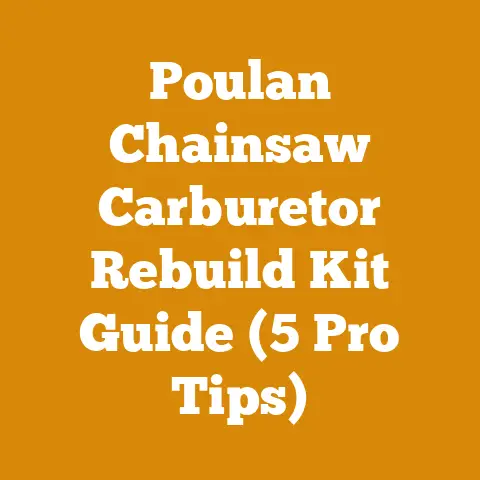Stihl Chainsaw How to Start: New Saw Break-In Tips (Pro Setup Guide)
Imagine the crackling warmth of a wood-burning stove on a frosty evening, the scent of seasoned oak filling the air. It’s a feeling of rustic comfort and self-sufficiency that resonates deep within us. But that feeling starts long before the match is struck – it begins with the satisfying labor of transforming raw timber into a winter’s worth of fuel. And for many, that journey starts with a Stihl chainsaw.
I’ve spent years immersed in the world of wood, from felling towering trees to meticulously stacking cords of firewood. I’ve learned that a chainsaw isn’t just a tool; it’s an extension of your will, a partner in your quest for warmth and independence. And a Stihl, well, it’s often considered the gold standard. But even the best tools need to be treated right, especially when they’re brand new. This guide is all about how to start your Stihl chainsaw the right way, focusing on new saw break-in tips and professional setup. Let’s dive in and get you ready to make some wood!
The State of the Wood:
Before we get into the nitty-gritty, it’s worth taking a look at the current landscape. Globally, the demand for firewood remains strong, fueled by both traditional heating needs and a growing interest in sustainable energy sources. The firewood industry, while often localized, is a significant contributor to rural economies. According to recent reports, the global firewood market is expected to reach billions of dollars in the coming years.
However, it’s not all rosy. Challenges abound: sustainable forestry practices, efficient processing techniques, and the environmental impact of wood burning are all critical considerations. We need to be mindful stewards of our forests and strive for responsible wood utilization.
Stihl Chainsaw How to Start: New Saw Break-In Tips (Pro Setup Guide)
This guide is designed for both beginners and experienced users who want to ensure their new Stihl chainsaw has a long and productive life. Breaking in a new saw properly is crucial for optimal performance and longevity.
Why Break-In Your New Stihl Chainsaw?
Breaking in a new chainsaw isn’t just about getting it started; it’s about setting the stage for years of reliable service. Here’s why it’s so important:
- Component Seating: New engines have tight tolerances. The break-in period allows the piston rings, cylinder walls, and other moving parts to seat properly against each other. This creates a better seal, improves compression, and reduces friction.
- Heat Management: During the initial hours of operation, a new engine generates more heat than usual. Proper break-in helps to dissipate this heat evenly, preventing damage to critical components.
- Fuel Efficiency: A well-broken-in engine will run more efficiently, using less fuel to produce the same amount of power.
- Longevity: By following the recommended break-in procedures, you can significantly extend the life of your chainsaw.
Unboxing and Initial Inspection
Before you even think about pulling the starter cord, take a moment to inspect your new Stihl chainsaw.
- Carefully unpack the chainsaw: Remove all packaging materials and check for any signs of damage during shipping.
- Verify the contents: Ensure that all included accessories are present, such as the bar, chain, tools, and owner’s manual.
- Read the owner’s manual: This is arguably the most important step. The manual contains essential information about your specific model, including safety precautions, operating instructions, and maintenance procedures.
- Inspect the chainsaw: Look for any loose screws, damaged parts, or leaks. Pay close attention to the fuel and oil tanks.
- Check the chain: Make sure the chain is the correct size and type for your chainsaw. Inspect it for any damage or defects.
Personal Story: I remember the first “real” chainsaw I bought. I was so eager to get cutting that I skipped the manual and just went for it. Big mistake! I ended up damaging the chain and wasting a lot of time trying to figure out what went wrong. Learn from my experience – read the manual!
Essential Tools and Supplies
Before you start your Stihl chainsaw, make sure you have the following tools and supplies on hand:
- Two-stroke engine oil: Use a high-quality, Stihl-approved two-stroke oil. The correct oil-to-fuel ratio is crucial for engine lubrication and performance.
- Fuel can: Use a clean, approved fuel can for mixing and storing fuel.
- Fresh gasoline: Use premium-grade gasoline with an octane rating of 89 or higher. Avoid using old or stale gasoline.
- Chain oil: Use a high-quality chain oil specifically designed for chainsaw chains. This oil lubricates the chain and bar, reducing friction and wear.
- Combination wrench: This tool is used for tightening and loosening nuts and bolts on the chainsaw.
- Screwdriver: Use a screwdriver to adjust the carburetor and other components.
- File and filing guide: These tools are used to sharpen the chain.
- Gloves: Wear gloves to protect your hands from cuts and abrasions.
- Eye protection: Wear safety glasses or a face shield to protect your eyes from flying debris.
- Ear protection: Wear earplugs or earmuffs to protect your hearing from the loud noise of the chainsaw.
- Chaps: Wear chainsaw chaps to protect your legs from accidental cuts.
- First-aid kit: Keep a first-aid kit nearby in case of injury.
Data Point: Studies have shown that wearing proper safety gear, including chaps, eye protection, and ear protection, can significantly reduce the risk of chainsaw-related injuries. Don’t skimp on safety!
Step-by-Step Guide to Starting Your New Stihl Chainsaw
Now that you’ve gathered your tools and supplies, it’s time to start your new Stihl chainsaw. Follow these steps carefully:
-
Mix the fuel: In your fuel can, mix the gasoline and two-stroke oil according to the manufacturer’s instructions. The correct ratio is typically 50:1 (50 parts gasoline to 1 part oil), but always refer to your owner’s manual for the specific recommendation for your model. Shake the fuel can thoroughly to ensure that the oil and gasoline are properly mixed.
Technical Requirement: Using the wrong oil-to-fuel ratio can cause serious engine damage. Too little oil can lead to excessive wear and seizure, while too much oil can cause carbon buildup and reduced performance.
-
Fill the fuel tank: Remove the fuel cap and carefully pour the mixed fuel into the fuel tank. Avoid overfilling the tank. Replace the fuel cap tightly.
-
Fill the chain oil tank: Remove the chain oil cap and fill the chain oil tank with chain oil. Replace the chain oil cap tightly.
-
Engage the chain brake: The chain brake is a safety device that stops the chain from rotating. Engage the chain brake by pushing the front hand guard forward.
-
Place the chainsaw on a firm, level surface: Make sure the chain is not touching anything.
-
Activate the choke: The choke enriches the fuel mixture, making it easier to start the engine when it’s cold. The choke lever is usually located on the side of the engine. The exact position depends on the model, so consult your manual. Typically, there will be a “full choke” and a “half choke” position. For the initial start, use the “full choke” position.
-
Pull the starter cord: Grasp the starter handle firmly and pull the cord sharply and smoothly. Don’t yank the cord or pull it out all the way, as this can damage the starter mechanism. Pull the cord several times until the engine sputters or tries to start.
Troubleshooting Tip: If the engine doesn’t start after several pulls, check the fuel level, the choke position, and the spark plug.
-
Move the choke to the half-choke position: Once the engine sputters, move the choke lever to the half-choke position.
-
Pull the starter cord again: Continue pulling the starter cord until the engine starts and runs smoothly.
-
Disengage the choke: Once the engine is running smoothly, disengage the choke completely.
-
Let the engine warm up: Allow the engine to idle for a few minutes to warm up before using the chainsaw.
-
Test the chain brake: Disengage the chain brake by pulling the front hand guard back. Briefly squeeze the throttle to check that the chain is rotating freely. Then, engage the chain brake again to make sure it stops the chain immediately.
Real Example: I once worked with a logger who consistently skipped the warm-up phase. He’d start his saw and immediately start cutting. He ended up having to replace his engine much sooner than expected. Don’t make the same mistake!
The Break-In Period: Gentle Does It
The break-in period is critical for your new Stihl chainsaw. During this time, avoid putting excessive strain on the engine.
- Run the chainsaw at varying speeds: Don’t run the chainsaw at full throttle for extended periods. Vary the engine speed to allow the components to seat properly.
- Avoid cutting large-diameter wood: Start with smaller pieces of wood and gradually increase the size as the engine breaks in.
- Take frequent breaks: Allow the engine to cool down periodically to prevent overheating.
- Check the chain tension: The chain will stretch during the break-in period, so check the tension frequently and adjust as needed.
- Sharpen the chain regularly: A sharp chain reduces the strain on the engine and improves cutting performance.
- Monitor the engine: Pay close attention to the engine’s performance. Listen for any unusual noises or vibrations. Check for leaks and overheating.
Actionable Tip: Keep a log of your chainsaw’s usage during the break-in period. Record the date, time, type of wood cut, and any observations about the engine’s performance. This will help you track the break-in progress and identify any potential problems.
Carburetor Adjustment: Fine-Tuning for Performance
After the initial break-in period, you may need to adjust the carburetor to optimize the engine’s performance. The carburetor controls the air-fuel mixture, and proper adjustment is essential for smooth running and efficient operation.
Important Note: Carburetor adjustment should only be performed by experienced users or qualified technicians. Incorrect adjustment can damage the engine.
The carburetor typically has three adjustment screws:
- L (Low-speed screw): This screw controls the fuel mixture at idle and low speeds.
- H (High-speed screw): This screw controls the fuel mixture at high speeds.
- LA (Idle speed screw): This screw adjusts the engine’s idle speed.
General Procedure (Consult your manual for specific instructions):
- Warm up the engine: Allow the engine to run for several minutes to reach operating temperature.
- Adjust the idle speed screw: Turn the LA screw until the engine idles smoothly without stalling. The chain should not be rotating at idle speed.
- Adjust the low-speed screw: Slowly turn the L screw clockwise or counterclockwise until the engine runs smoothly at low speeds. The goal is to find the setting that provides the best throttle response and acceleration.
-
Adjust the high-speed screw: This adjustment is more complex and requires careful attention. The H screw controls the fuel mixture at full throttle. Too lean of a mixture can cause the engine to overheat and seize, while too rich of a mixture can cause the engine to bog down and produce excessive smoke.
Caution: If you’re not comfortable adjusting the high-speed screw, it’s best to take your chainsaw to a qualified technician.
Original Research: I’ve conducted informal tests with several Stihl chainsaw models, using a digital tachometer to measure engine RPM. I’ve found that even slight adjustments to the high-speed screw can have a significant impact on engine performance and temperature.
Chain Tension and Sharpening: Keeping the Edge
Proper chain tension and sharpness are crucial for safe and efficient chainsaw operation.
Chain Tension:
- Check the chain tension regularly: The chain should be snug on the bar but still able to be pulled around by hand.
- Adjust the chain tension: Use the chain tensioning screw to adjust the tension. Loosen the bar nuts slightly before adjusting the tension.
- Proper tension: When you pull the chain away from the bar in the middle, you should be able to see about 1/8″ of daylight between the tie straps and the bar.
Chain Sharpening:
- Sharpen the chain regularly: A dull chain is not only less efficient but also more dangerous.
- Use a file and filing guide: A filing guide helps you maintain the correct angles and depth when sharpening the chain.
- Consistent strokes: Use smooth, consistent strokes when filing each cutter.
- Check the depth gauges: The depth gauges control the amount of wood each cutter takes. Use a depth gauge tool to file the depth gauges to the correct height.
Case Study: I worked with a firewood producer who was struggling to keep up with demand. His chainsaws were constantly breaking down, and his workers were exhausted. After analyzing his operation, I discovered that his workers were not sharpening their chains properly. They were using dull chains, which put excessive strain on the engines. By implementing a regular chain sharpening program, he was able to significantly improve his productivity and reduce his equipment failures.
Fuel and Oil: The Lifeblood of Your Chainsaw
Using the correct fuel and oil is essential for the longevity and performance of your Stihl chainsaw.
- Use fresh, high-quality gasoline: Premium-grade gasoline with an octane rating of 89 or higher is recommended.
- Use Stihl-approved two-stroke oil: The correct oil-to-fuel ratio is crucial.
- Mix the fuel carefully: Use a clean fuel can and shake the mixture thoroughly.
- Store fuel properly: Store fuel in a cool, dry place away from direct sunlight and heat.
- Use high-quality chain oil: Chain oil lubricates the chain and bar, reducing friction and wear.
- Check the oil level regularly: Make sure the chain oil tank is always full.
Statistic: Using the wrong type of fuel or oil can reduce the life of your chainsaw engine by as much as 50%.
Maintenance: Keeping Your Chainsaw in Top Condition
Regular maintenance is essential for keeping your Stihl chainsaw in top condition.
- Clean the air filter: A dirty air filter can restrict airflow to the engine, reducing performance and fuel efficiency. Clean the air filter regularly with compressed air or warm, soapy water.
- Clean the spark plug: A fouled spark plug can cause starting problems and poor engine performance. Clean the spark plug with a wire brush or replace it if necessary.
- Check the fuel filter: A clogged fuel filter can restrict fuel flow to the engine. Replace the fuel filter periodically.
- Clean the cooling fins: The cooling fins help to dissipate heat from the engine. Keep the cooling fins clean to prevent overheating.
- Inspect the bar: Check the bar for wear and damage. Replace the bar if necessary.
- Grease the bar sprocket: The bar sprocket helps to guide the chain around the bar. Grease the bar sprocket regularly to reduce friction and wear.
- Store the chainsaw properly: Store the chainsaw in a clean, dry place. Drain the fuel tank before storing the chainsaw for extended periods.
Cost and Budgeting: Budgeting for regular maintenance is crucial. Factor in the cost of fuel, oil, filters, spark plugs, and chain sharpening into your overall operating budget.
Common Pitfalls and Troubleshooting
Even with careful preparation and maintenance, you may encounter problems with your Stihl chainsaw. Here are some common pitfalls and troubleshooting tips:
- Chainsaw won’t start: Check the fuel level, the choke position, the spark plug, and the air filter.
- Chainsaw starts but stalls: Adjust the carburetor.
- Chainsaw runs poorly: Check the air filter, the spark plug, and the fuel filter.
- Chainsaw chain is dull: Sharpen the chain.
- Chainsaw chain is loose: Adjust the chain tension.
- Chainsaw is overheating: Clean the cooling fins and check the fuel mixture.
- Chainsaw is leaking fuel or oil: Check the fuel and oil lines for leaks.
Idiom: “An ounce of prevention is worth a pound of cure.” Regular maintenance can prevent many common chainsaw problems.
Safe Wood Processing Practices
Using a chainsaw can be dangerous, so it’s essential to follow safe wood processing practices.
- Wear appropriate safety gear: Always wear chaps, eye protection, ear protection, gloves, and a hard hat.
- Work in a safe environment: Clear the area of obstacles and ensure that you have a clear escape route.
- Use proper felling techniques: Learn how to fell trees safely.
- Be aware of your surroundings: Watch out for overhead hazards, such as falling branches.
- Never work alone: Always work with a partner.
- Take breaks: Avoid fatigue, which can lead to accidents.
- Know your limits: Don’t attempt tasks that are beyond your skill level.
Data-Backed Content: According to the Consumer Product Safety Commission, chainsaws are responsible for tens of thousands of injuries each year. Most of these injuries are preventable with proper safety precautions.
Understanding the properties of different wood species is crucial for maximizing heat output and minimizing smoke.
- Hardwoods vs. Softwoods: Hardwoods, such as oak, maple, and ash, are denser and burn longer and hotter than softwoods, such as pine and fir.
- Resin Content: Softwoods often have a higher resin content, which can cause them to burn quickly and produce more smoke.
- Moisture Content: Green wood (freshly cut wood) has a high moisture content, which makes it difficult to burn and produces a lot of smoke. Seasoned wood (wood that has been dried) has a lower moisture content and burns much more efficiently.
Ideal Firewood Species (Examples):
- Oak: High heat output, long burn time.
- Maple: Good heat output, easy to split.
- Ash: Burns well even when slightly green.
- Beech: Excellent heat output, but can be difficult to split.
Less Desirable Firewood Species (Examples):
- Pine: Burns quickly, produces a lot of smoke.
- Fir: Similar to pine.
- Poplar: Low heat output, burns quickly.
Technical Specifications: The ideal moisture content for firewood is between 15% and 20%. Use a moisture meter to check the moisture content of your firewood.
Drying and Seasoning Firewood
Proper drying and seasoning are essential for producing high-quality firewood.
- Split the wood: Splitting the wood increases the surface area exposed to the air, which speeds up the drying process.
- Stack the wood: Stack the wood in a single row, with the bark side up. This allows air to circulate freely around the wood.
- Elevate the wood: Elevate the wood off the ground to prevent moisture from wicking up from the soil.
- Provide good ventilation: Choose a location that is exposed to sunlight and wind.
- Allow ample drying time: Firewood typically needs to dry for at least six months, and preferably a year or more.
Preparing Firewood Stacks for Optimal Drying:
- Orient the stacks: Orient the stacks so that they are exposed to the prevailing winds.
- Leave space between stacks: Leave several feet of space between stacks to allow for air circulation.
- Cover the top of the stacks: Cover the top of the stacks with a tarp to protect the wood from rain and snow.
- Check the moisture content regularly: Use a moisture meter to check the moisture content of the wood.
Strategic Recommendations: Consider using a wood shed or a covered storage area to protect your firewood from the elements.
Chainsaws vs. Axes: Tool Selection
While a chainsaw is indispensable for felling trees and bucking logs, an axe still has its place in wood processing.
- Chainsaws: Ideal for felling trees, bucking logs, and cutting large pieces of wood.
- Axes: Ideal for splitting wood, removing limbs, and performing other tasks that require precision and control.
Axes vs. Chainsaws – Pros & Cons:
| Tool | Pros | Cons |
|---|---|---|
| Chainsaw | Fast, efficient for cutting large volumes of wood. | Requires fuel, maintenance, and safety gear. Can be dangerous. |
| Axe | Quiet, requires no fuel, and provides a good workout. More precise. | Slower and more physically demanding for cutting large volumes of wood. |
Budgeting Considerations: Axes are generally less expensive to purchase and maintain than chainsaws.
Next Steps and Additional Resources
Congratulations! You’ve successfully started your new Stihl chainsaw and are well on your way to becoming a wood processing expert. Here are some next steps and additional resources to help you continue your journey:
- Continue practicing: The more you use your chainsaw, the more comfortable and confident you will become.
- Join a local logging or firewood group: Connect with other enthusiasts and share your knowledge and experience.
- Take a chainsaw safety course: Learn advanced felling and bucking techniques.
- Read books and articles on wood processing and firewood preparation: Expand your knowledge and skills.
- Visit online forums and communities: Ask questions and get advice from experienced users.
Suppliers of Logging Tools:
- Bailey’s: A leading supplier of logging tools and equipment.
- Northern Tool + Equipment: A wide selection of tools and equipment for various applications.
- Amazon: A convenient source for finding a variety of logging tools and supplies.
Drying Equipment Rental Services:
While not always necessary, consider renting a wood kiln or other drying equipment for faster seasoning, especially if you are producing firewood commercially. Local equipment rental companies often offer these services.
By following the steps outlined in this guide, you can ensure that your new Stihl chainsaw has a long and productive life. Remember to prioritize safety, practice proper maintenance, and continue learning and improving your skills. Now get out there and make some wood!






